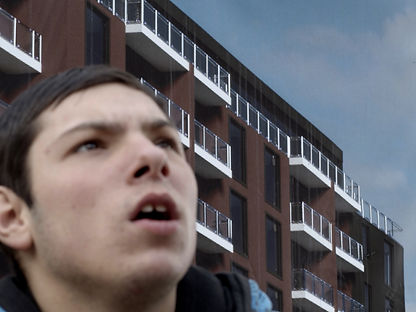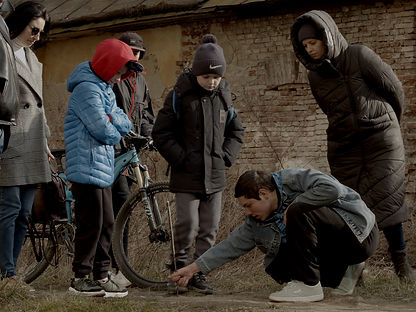
신세계로부터
From the New World
Yarema & Himey
Ingel Vaikla
Andriy Rachinskiy & Daniil Revkovskiy
Laila Pakalnina
Silvestar Kolbas
Anastasija Pirozenko
Yuriy Hrytsyna
Oleksiy Radynski
제16회 부산국제비디오아트페스티발은 주제전 《신세계로부터(From the New World)》에서 포스트 소비에트 도시와 공간을 탐구하는 9점의 작품을 선보입니다. 소비에트 시기의 건축과 도시에 대한 미학적 분석과 관찰은 포스트 소비에트 국가들의 비디오 아트와 영화에서 두드러지는 하나의 경향입니다. 이번 주제전에서는 이러한 경향에 속하는 포스트 소비에트 세대와 그 이후에 태어난 작가들의 작업을 소개하는 동시에 지금도 계속되고 있는 이들 지역의 노동 문제, 독립 이후의 정체성, 시민운동 등의 주제를 다루며 적극적으로 정치적 목소리를 내고 있는 작가들의 작업들을 함께 소개합니다.
16th Busan International Video Art Festival presents nine video artworks in the thematic exhibition 《From the New World》. The exhibition explores post-Soviet cities and spaces. The aesthetic analysis and observation of Soviet architecture and cities are prominent trends in post-Soviet countries' video art and cinema. The exhibition introduces the works of the post-Soviet and the subsequent generation of artists, as well as the works of active political voices dealing with labor problems, post-independence identity, and civic movements.
Yarema & Himey, Dedicated to the Youth of the World II, 2019, Single-channel video, color, sound, 9min.


알렉산드르 도브젠코의 영화 스튜디오는 테크노사운드를 통해 댄스 플로어와 동기화된 군중, 스포트라이트로 변형된다. 카메라는 클럽의 풍경을 멀리 또 가까이 담으며 낭만적 고양과 현대적 소외의 감각을 동시에 만들어낸다. 이곳에서 키이우의 젊은이들은 일상으로부터의 특별한 탈출을 기다리고 준비한다. 일상에 대한 거부와 도피는 마치 의식과도 같은 묘한 풍경을 만들어낸다. 아침이 오면 카메라는 테크노 클럽 바깥의 얼굴들에 섬세하게 초��점을 맞춘다. 청춘들은 아직 새로운 날과 오래된 현실을 받아들일 준비를 하지 못했다. 영화는 유토피아 이후의 정적인 초상으로 마무리된다.
The focus of the film is the techno-rave Cxema and the youth, on which the camera is carefully focused the next morning after the event. The space of Dovzhenko’s film-studio is transformed into a dancefloor, a synchronized crowd, spotlights, arrhythmic synthetic sound by Stanislav Tolkachev — the camera moves away and approaches, creating a sense of romantic “exaltation” and at the same time a modern “alienation”. This is the place and meeting that the youth of Kyiv are waiting for and preparing for — this particular escape from everyday life, rejection of it — evokes strange feelings of modern ritual. But what does it mean? The film ends with “portraits”, almost static shots, faces “after” utopia. Characters of the film are not ready to accept the new day and its old reality.
Yarema & Himey, New City of Friends, 2021, Single-channel video, color, sound, 9min.


<친구들의 새로운 도시>는 근대 절충주의 도시 계획을 바탕으로 구성된 우크라이나의 도시 콜로미야(Kolomyia)를 배경으로 한다. 영화 속에서 오스트리아-헝가리 제국 시대의 오스트리아 막사가 허물어지는 동시에 동네에 사는 10대 소년 막심(Maksym)이 자기만의 즉흥적인 여행을 통해 이웃 가족을 찾아간다. 그의 여정은 도시 속 소외된 지역과 주변 환경을 연결하면서 도시의 현대적 경관을 드러낸다.
The town of Kolomyia emerges in videowork through the eclecticism of modern urban planning. The destruction of the Austrian barracks built during the Austro-Hungarian Empire is accompanied by the preservation of its valuable bricks by the builders. Local teenager Maksym’s fully improvised excursion to the families of the neighborhood connects unconnected areas of the town and surroundings and reveals contemporary cityscape of the town.
Ingel Vaikla, The House Guards, 2015, Single-channel video, 26min.


에스토니아 건축가 라이네 카르프가 설계한 린나할(구 레닌 문화 체육 궁전)은 1980년 탈린에서 열린 모스크바 올림픽 요트 경기를 위해 준공되었다. 3,000명까지 수용 가능한 아이스 링크와 4,600석 규모의 공연장을 갖춘 린나할은 각종 주요 행사의 개최 장소가 되었지만 2009년부터 폐쇄되어 용도 변경을 기다리고 있다. <더 하우스 가드>는 폐쇄된 린나할과 이를 지켜온 관리인 페테르의 이중 초상으로, 그의 눈으로 본 전설적인 건물의 쇠퇴와 린나할을 배경으로 한 그의 개인사를 그려낸다.
Linnahall, Lenin Palace of Culture and Sport, in Tallinn, Estonia was built for the 22nd Summer Olympic Games which were hosted in Moscow in 1980. The building became later highly popular amusement venue for ice skating, pop concerts and political meetings. However, since 2009 the building has been closed for the public waiting for repurposing. The House Guard is a double portrait – of the modernist Tallinn Linnahall concert and sports venue and its warm-hearted disabled caretaker Peeter, who are both bound by seclusion. The film tells the story of the decline of a legendary, politically loaded piece of architecture through one man’s eyes, and the personal story of a man against the backdrop of a vanishing building.
Ingel Vaikla, The Shift, 2019, Single-channel video, 10min., loop.


우크라이나 북부의 체르니히우–오우루치 철도 노선은 벨라루스 남부와 체르노빌 금지 구역을 통과한다. 매일 아침 3,000명 사람들이 노동자 열차를 타고 폐쇄된 원전으로 간다. 1986년 체르노빌 원전 사고는 역사상 최악의 핵참사 중 하나로, 여전히 구 소련의 몰락을 상징한다. <더 시프트>는 다차원의 시간과 공간을 이동하는 건축적 비공간으로서의 기차를 연구한다.
The Chernihiv–Ovruch railway line in northern Ukraine passes through South Belarus and the restricted Chernobyl Exclusion Zone. Every morning 3000 people take the “workers’ train” to the decommissioned nuclear power plant. In 1986 Chernobyl power station reactor No. 4 was the site of one of the biggest nuclear catastrophes in history. The accident still marks the beginning of the downfall of former USSR. The video studies the shape of the train as an architectural non-space which moves through multiple dimensions of time and space.
Andriy Rachinskiy & Daniil Revkovskiy, Labor Safety in the Region of Dnipropetrovsk, 2018, Single-channel video, 22min.


일명 파운드 푸티지 재난 영화인 <드니프로페트로우스카 지역의 노동보호>는 소비에트 시기 등장한 우크라이나 중부의 거대한 중공업 클러스터 드니프로페트로우스카를 배경으로 한다. 산업 노동자들이 업로드한 방대한 온라인 비디오 아카이브를 통해 열악한 노동 조건과 환경 오염, 계급 투쟁이 화면 밖으로 드러난다. 노동자들의 휴대전화는 위로부터의 계급 전쟁의 증거 채집을 위한 궁극적인 무기로써 사용된다.
A documentary collection of videos found by artists on social networks, something between a tragicomedy and a film about an environmental disaster. Workers of industrial enterprises of the Dnipropetrovsk region (Ukraine) and residents of nearby areas filmed working days and emergencies on their gadgets. Heavy everyday life is complemented by flashes of non-triviality. However, such videos and their proliferation on the Internet are evidence of an ongoing class war (the use of recording devices at work is generally strictly prohibited). The directors have retained the original voice acting, which is distinguished by a bright emotional coloring, a mixture of surprise and delight. Scenes of (post)industrial hell alternate with unexpected situations of humor and humanity.
Laila Pakalniņa, The First Bridge, 2020, Single-channel video, stereo sound,
11min. 31sec.


다우가바 강은 벨라루스에서 라트비아로 흐른다. 크라슬라바 다리는 라트비아 영토에서 다우가바 강을 건너기 위한 첫 번째 관문이다. <첫 번째 다리>는 고전적인 흑백 화면과 적막한 사운드를 통해 여러 각도에서 다리에 근접한다. 두 강둑 사이를 지나는 자동차와 보행자의 끝없는 움직임, 그리고 인간 문명과 야생의 풍경이 영화 속에서 대비된다.
Krāslava bridge is the first bridge over the river Daugava in the territory of Latvia - the gate for the Daugava river from Belarus to Latvia.
Every film is about time, but ours maybe a bit more than every as it was shot on Kodak Eastman Plus-X Negative Film 5231, acquired in the year 1997 and discovered intact in 2018. So we are dedicating The First Bridge to Film stock.
Silvestar Kolbas, The Film Factory, 2022, Experimental documentary, 15min.


<더 필름 팩토리>는 지금은 폐쇄된 포토케미카(Fotokemika) 필름 공장에 대한 포토에세이 영화이다. 인화지와 필름을 생산하던 포토케미카 공장을 담은 흑백 사진은 공장에서 생산된 필름으로 촬영한 것이다. 영화는 재료 자체의 노화를 통해 시간의 흐름을 보여주는 동시에 산업화의 붕괴와 노동자 권리 상실이라는 부정적 측면을 다룬다.
I started doing photography when I was very young and expected to do it all my life. At that time, the most available photographic material for us was from the local Fotokemika factory.
When I saw that abandoned film factory a few years ago, I experienced it very emotionally. I photographed those empty factory spaces and the objects found in them, using films that were made here. Films had expired and photographic reproduction was often poor. I even liked that because it further testified to aging and transience. That's how many photos were created that I exhibited at photography exhibitions. But the whole story is told only by connecting the photos into a film sequence.
Anastasija Piroženko, Syndromes of Mimicry, 2017, Single-channel video, stereo sound, 17min. 41sec.


소련 해체 이후 리투아니아는 소비에트 이데올로기로부터 자유로워졌다. 고유한 정체성과 정치 구조의 탐색 과정에서 새로운 독립 국가는 서양의 문화, 개념, 유행, 패션을 활용하기 시작했다. 이것은 종종 새롭게 채택된 관념과 동유럽 현실 간의 불일치를 초래했다. <모방 증후군>은 기묘한 현대 리투아니아의 풍경을 풍자하는 동시에 사회, 정치, 문화 분야에서 정체성 탐색하기 위한 다양한 시도를 보여준다.
What could possibly link a village nightclub where a musician mindlessly recites popular Western melodies, a mute black man delivering flowers in a Hussar uniform, and a yoga class attracting people in search of religious identity?
For Anastasija, those are the syndromes of mimicry - the imitation of the Western concepts that occurred in Lithuania after regaining its independence. In the series of short sketches, the satire presents various attempts in the identity search in social, political and cultural field.
Yuriy Hrytsyna, Varta1, Lviv, Ukraine, 2015, Single-channel video, VHS, 64min.


<바르타1, 리비우, 우크라이나>는 온라인 동원, 직접 민주주의, 위계질서, 폭력의 개념을 탐구하는 실험적 다큐멘터리로 젤로(Zello) 온라인 무전 채널에서 녹음된 대화를 기반으로 제작되었다. 젤로는 우크라이나 서부 리비우에서 민병 순찰대를 조직한 자동차 운전자 커뮤니티가 무전을 위해 선택한 채널로, 영화 속 무전 대화는 2014년 2월 마이��단 시위로 친 러시아 성향의 우크라이나 정부가 붕괴된 직후의 짧은 공백기 동안 이루어졌다.
Varta1, Lviv, Ukraine is an experimental documentary that interrogates the notions of online mobilization, direct democracy, hierarchy, and violence. The film is based on conversations recorded on a Zello online radio channel, used by the community of car drivers who organized into a grassroots patrol militia in the city of Lviv in Western Ukraine. These conversations take place during the brief interregnum right after the collapse of the pro-Russian government of Ukraine, in the wake of the February 2014 Maidan uprising.